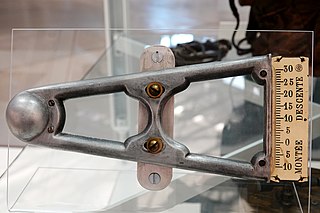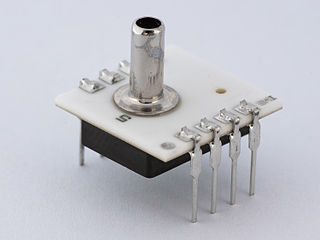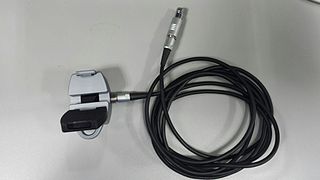
Pressure measurement is the analysis of an applied force by a fluid on a surface. Pressure is typically measured in units of force per unit of surface area. Many techniques have been developed for the measurement of pressure and vacuum. Instruments used to measure and display pressure in an integral unit are called pressure meters or pressure gauges or vacuum gauges. A manometer is a good example, as it uses the surface area and weight of a column of liquid to both measure and indicate pressure. Likewise the widely used Bourdon gauge is a mechanical device, which both measures and indicates and is probably the best known type of gauge.

Capacitance is the ratio of the change in electric charge of a system to the corresponding change in its electric potential. There are two closely related notions of capacitance: self capacitance and mutual capacitance. Any object that can be electrically charged exhibits self capacitance. A material with a large self capacitance holds more electric charge at a given voltage than one with low capacitance. The notion of mutual capacitance is particularly important for understanding the operations of the capacitor, one of the three elementary linear electronic components.
In electrical engineering, partial discharge (PD) is a localized dielectric breakdown (DB) of a small portion of a solid or fluid electrical insulation (EI) system under high voltage (HV) stress. While a corona discharge (CD) is usually revealed by a relatively steady glow or brush discharge (BD) in air, partial discharges within solid insulation system are not visible.

A touchscreen, or touch screen, is both an input and output device and normally layered on the top of an electronic visual display of an information processing system. The display is often an LCD or OLED display while the system is usually a laptop, tablet, or smartphone. A user can give input or control the information processing system through simple or multi-touch gestures by touching the screen with a special stylus or one or more fingers. Some touchscreens use ordinary or specially coated gloves to work while others may only work using a special stylus or pen. The user can use the touchscreen to react to what is displayed and, if the software allows, to control how it is displayed; for example, zooming to increase the text size.

An inclinometer or clinometer is an instrument used for measuring angles of slope, elevation, or depression of an object with respect to gravity's direction. It is also known as a tilt indicator, tilt sensor, tilt meter, slope alert, slope gauge, gradient meter, gradiometer, level gauge, level meter, declinometer, and pitch & roll indicator. Clinometers measure both inclines and declines using three different units of measure: degrees, percent, and topo. Astrolabes are inclinometers that were used for navigation and locating astronomical objects from ancient times to the Renaissance.

A pressure sensor is a device for pressure measurement of gases or liquids. Pressure is an expression of the force required to stop a fluid from expanding, and is usually stated in terms of force per unit area. A pressure sensor usually acts as a transducer; it generates a signal as a function of the pressure imposed. For the purposes of this article, such a signal is electrical.

An electronic component is any basic discrete device or physical entity in an electronic system used to affect electrons or their associated fields. Electronic components are mostly industrial products, available in a singular form and are not to be confused with electrical elements, which are conceptual abstractions representing idealized electronic components.

A variable capacitor is a capacitor whose capacitance may be intentionally and repeatedly changed mechanically or electronically. Variable capacitors are often used in L/C circuits to set the resonance frequency, e.g. to tune a radio, or as a variable reactance, e.g. for impedance matching in antenna tuners.
Parasitic capacitance, or stray capacitance is an unavoidable and usually unwanted capacitance that exists between the parts of an electronic component or circuit simply because of their proximity to each other. When two electrical conductors at different voltages are close together, the electric field between them causes electric charge to be stored on them; this effect is parasitic capacitance. All actual circuit elements such as inductors, diodes, and transistors have internal capacitance, which can cause their behavior to depart from that of 'ideal' circuit elements. Additionally, there is always non-zero capacitance between any two conductors; this can be significant at higher frequencies with closely spaced conductors, such as wires or printed circuit board traces. Parasitic capacitance is a significant problem in high frequency circuits and is often the factor limiting the operating frequency and bandwidth of electronic components and circuits.
Level sensors detect the level of liquids and other fluids and fluidized solids, including slurries, granular materials, and powders that exhibit an upper free surface. Substances that flow become essentially horizontal in their containers because of gravity whereas most bulk solids pile at an angle of repose to a peak. The substance to be measured can be inside a container or can be in its natural form. The level measurement can be either continuous or point values. Continuous level sensors measure level within a specified range and determine the exact amount of substance in a certain place, while point-level sensors only indicate whether the substance is above or below the sensing point. Generally the latter detect levels that are excessively high or low.

A capacitor is a device that stores electrical energy in an electric field. It is a passive electronic component with two terminals.

Ultrasonic transducers and ultrasonic sensors are devices that generate or sense ultrasound energy. They can be divided into three broad categories: transmitters, receivers and transceivers. Transmitters convert electrical signals into ultrasound, receivers convert ultrasound into electrical signals, and transceivers can both transmit and receive ultrasound.
An electromagnetic diaphragm is a form of capacitive sensor used on an electronic stethoscope. The diaphragm is coated with a conductive material. A conductive plate is positioned behind and parallel to the diaphragm, so that the two conductive elements form a capacitor. Capacitance is a function of plate area, dielectric properties of the space between the conductors, and the distance between the conductors. It is this latter parameter which is modulated by vibration such that the capacitance varies with the distance between the electromagnetic diaphragm and the plate, forming an acoustic sensor.
Capacitance sensors use capacitance to measure the dielectric permittivity of a surrounding medium. The configuration is like the neutron probe where an access tube made of PVC is installed in the soil; probes can also be modular (comb-like) and connected to a logger. The sensing head consists of an oscillator circuit, the frequency is determined by an annular electrode, fringe-effect capacitor, and the dielectric constant of the soil. Each capacitor sensor consists of two metal rings mounted on the circuit board at some distance from the top of the access tube. These rings are a pair of electrodes, which form the plates of the capacitor with the soil acting as the dielectric in between. The plates are connected to an oscillator, consisting of an inductor and a capacitor. The oscillating electrical field is generated between the two rings and extends into the soil medium through the wall of the access tube. The capacitor and the oscillator form a circuit, and changes in dielectric constant of surrounding media are detected by changes in the operating frequency. The capacitance sensors are designed to oscillate in excess of 100 MHz inside the access tube in free air. The output of the sensor is the frequency response of the soil’s capacitance due to its soil moisture level.
In electrical engineering, capacitive sensing is a technology, based on capacitive coupling, that can detect and measure anything that is conductive or has a dielectric different from air. Many types of sensors use capacitive sensing, including sensors to detect and measure proximity, pressure, position and displacement, force, humidity, fluid level, and acceleration. Human interface devices based on capacitive sensing, such as trackpads, can replace the computer mouse. Digital audio players, mobile phones, and tablet computers use capacitive sensing touchscreens as input devices. Capacitive sensors can also replace mechanical buttons.

Capacitors have many uses in electronic and electrical systems. They are so ubiquitous that it is rare that an electrical product does not include at least one for some purpose.

Capacitive displacement sensors "are non-contact devices capable of high-resolution measurement of the position and/or change of position of any conductive target". They are also able to measure the thickness or density of non-conductive materials. Capacitive displacement sensors are used in a wide variety of applications including semiconductor processing, assembly of precision equipment such as disk drives, precision thickness measurements, machine tool metrology and assembly line testing. These types of sensors can be found in machining and manufacturing facilities around the world.

Bubble sensors are used to detect the presence of bubbles in fluid filled tubes. They play a vital role in many fields, including medical technology, process control, pharmaceuticals, and the petroleum industry. The most common type of sensors used are ultrasonic or capacitor based.
A force-sensing capacitor is a material whose capacitance changes when a force, pressure or mechanical stress is applied. They are also known as "force-sensitive capacitors". They can provide improved sensitivity and repeatability compared to force-sensitive resistors but traditionally required more complicated electronics.
A stretch sensor is a sensor which can be used to measure deformation and stretching forces such as tension or bending. They are usually made from a material that is itself soft and stretchable.











